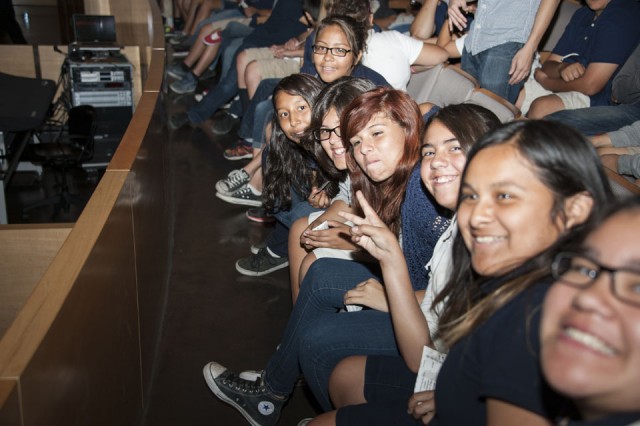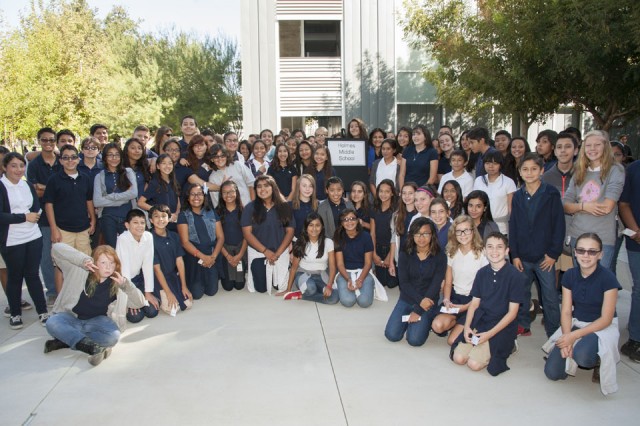VPAC Matinee Series Brings Fine Arts to Local Schoolchildren
Seventh grader Caroline Smith looked up in awe of the Great Hall of the Valley Performing Arts Center (VPAC).
“This is my first time here,” she said. “It’s so huge!”
Smith, an honors student from Holmes Middle School, was about to witness her first fine arts experience with 800 fellow students from local schools. This time, the performance was the Swiss silent theater group Mummenschanz on Oct. 24.
She is just one of more than 12,000 K-12 students from around the San Fernando Valley who have enjoyed the opportunity to be a part of the Student Matinee Series, an ongoing year-round program at California State University, Northridge that brings free, high-caliber artistic experiences to local students.
The program, which began in 2011, has been providing local schoolchildren firsthand experience with professional performers, which can be used in the classroom to enhance their understanding of the arts. Since art recently became a common core standard for the Los Angeles Unified School District, teachers from these schools will be able to use the performances as part of the curriculum to teach fine arts, said Anthony Cantrell, director of arts education at the VPAC.
“LAUSD recently stated that the arts should be a core subject, which we in the arts knew they should have been all along,” he said.
The series also tied into the VPAC’s mission to serve the Northridge community, he said. Cantrell, who has 20 years of experience as a high school theater teacher, helped prep many of the students for the Mummenschanz performance.
“I help put their minds and bodies into the Mummenschanz performer, as opposed to just giving them a handout,” he said. “With my background in education, it has led me to structure the matinees as a learning experience and not just a field trip. I go to their schools as much as I can to offer pre-performance workshops.”
Students from the international humanities magnet Holmes Middle School discussed what they expected and learned about silent theater before entering the Great Hall, such as interpreting body language and working as a unit to send a message.
Diego Borgsdorf, another Holmes seventh grader, was eager to see how the performers would work together.
“I want to see how they act as an ensemble and put the group’s needs in front of [their] own,” he said.
Mummenschanz lit up the stage with acts such as a giant yellow slinky playing catch with a mammoth red balloon and the audience, a silver ribbon dancing in a black background, and red lights reflecting off shimmering and crackling sheets to imitate what could be interpreted as fire.
With the LAUSD’s new standard, arts will be integrated into different disciplines in the classroom, such as health sciences and mathematics, Cantrell explained.
“Non-arts teachers can learn more about how to use arts more effectively in their classrooms,” he said. “There are strategies that we explore and share with teachers to weave them in more seamlessly, rather than as a separate lesson.”
Holmes Middle School health and life science instructor Dina Karathanas was one of the teachers who learned how to use art in her classroom. The common core standard aims to encourage students’ creativity, she said, and the series helps reinforce the new goal.
“This is an international humanities magnet, so the performance ties right into that,” she said.
Karathanas also said that because the series is free to join, the only cost was transportation.
“I love it. We are so close that we can walk,” she said. “The cost factor is huge.”
Students gathered around lunch tables outside the VPAC after the performance and reflected on their experiences. Borgsdorf said his favorite performance was the yellow slinky and the red balloon playing catch with the audience.
“I liked it because the character had emotions,” Borgsdorf said. “I was very into the expressions of their body language.”
Smith was amazed by the way the troupe used ordinary objects in an unconventional way, such as a skit that involved shiny plastic and a giant foam eye floating on the stage.
“I liked the one with the fish and the crocodile,” she said. “I thought it was funny how plastic could be a bunch of fish. It was neat.”
Smith also said Mummenschanz inspired her to be more creative.
“I’m in Girl Scouts, and we have to do skits,” she said. “I can use my imagination to make stories for the skits.”
Karathanas said she was glad the students could be more creative and get some outside help from CSUN in finding performances to discuss in class.
“Technology can take away imagination from the kids,” she said. “This [series] lets them create their own reactions.”
Cantrell said that while he is a department of one in providing a series for students, he believes it is worth it.
“I’m designing a program that I would have loved to take part in when I was a teacher,” he said.



 experience
experience